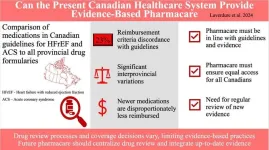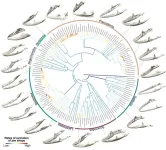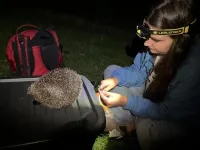(Press-News.org) Having a quality breakfast that provides the right amount of energy to face the day, around a quarter of daily intake, reduces the risk of cardiovascular disease. This is highlighted by a study conducted by the Hospital del Mar Research Institute and published in the Journal of Nutrition, Health and Aging. The study followed the progress of 383 participants in the PREDIMED-Plus project, a randomized clinical trial comparing the effects of a Mediterranean diet combined with physical activity versus dietary recommendations alone on cardiovascular disease. No previous study had analyzed the impact of energy intake and the nutritional quality of breakfast on these risk factors.
This new work considered two factors. First, the energy intake from breakfast relative to the total daily intake, distinguishing between an adequate calorie intake (20–30% of the daily total) and other levels. Second, the researchers analyzed the effects of consuming a high-quality breakfast with a proper balance of proteins, fats, fiber, and other nutrients. They found that consuming an adequate amount of energy in the morning and doing so with high-quality food contributed to reducing cardiovascular risk factors.
A Good Breakfast Reduces Obesity
The study followed participants for three years. All were aged between 55 and 75 and had overweight or obesity. Various cardiovascular risk factors were evaluated, including weight, waist circumference an indicator of abdominal obesity, lipid profile cholesterol and triglyceride levels, blood pressure, and diabetes markers.
The results indicate that participants who consumed 20–30% of daily energy intake in the morning had better outcomes for several risk factors. Their body weight evolved more favorably compared to participants who consumed more or less energy at breakfast. By the end of the study, these participants had a 2–3.5% lower body mass index and a 2–4% smaller waist circumference. Adequate energy intake at breakfast was also linked to significantly lower triglyceride levels (9–18% reduction) and higher HDL cholesterol levels (4–8.5% increase). Other markers showed less significant changes.
In terms of breakfast quality, the results were also positive. Participants who had a high-quality breakfast had 1.5% smaller waist circumference, 4% lower triglycerides, and 3% higher HDL cholesterol. A high-quality breakfast includes the right amounts of protein, high-value fats, fiber, and minerals such as potassium and iron, while avoiding excessive added sugars and saturated fats.
According to Álvaro Hernáez, researcher at the Hospital del Mar Research Institute, CIBER for Cardiovascular Diseases (CIBERCV), and professor at the Blanquerna Faculty of Health Sciences at Ramon Llull University, “Breakfast is the most important meal of the day, but what and how you eat it matters. Eating controlled amounts—not too much or too little—and ensuring good nutritional composition is crucial. Our data show that quality is associated with better cardiovascular risk factor outcomes. It's as important to have breakfast as it is to have a quality one.”
Dr. Montse Fitó, coordinator of the Cardiovascular Risk and Nutrition Research Group at the Hospital del Mar Research Institute and CIBER for Obesity and Nutrition (CIBEROBN), emphasizes that both energy adequacy and quality are key to preventing cardiovascular risk. “We have confirmed that dietary recommendations about food quality have been effective in improving risk factor evolution over time in adults at high cardiovascular risk,” she says.
The study’s results were adjusted to ensure they are attributable to breakfast energy intake and food quality rather than other factors. This leads Karla-Alejandra Pérez-Vega, a researcher at Hospital del Mar and CIBEROBN, to conclude, “Promoting healthy breakfast habits can contribute to healthy aging by reducing the risk of metabolic syndrome and associated chronic diseases, thereby improving quality of life.”
The study also involved researchers from the CIBER for Epidemiology and Public Health (CIBERESP) and received funding from the Carlos III Health Institute, the European Union, the European Research Council, the Government of Catalonia, and the Blanquerna Faculty of Health Sciences.
END
Having a good breakfast reduces cardiovascular risk
Having a quality breakfast that provides the 20-30% of daily energy intake in the morning reduces de risk of cardiovascular diseases
2024-12-11
ELSE PRESS RELEASES FROM THIS DATE:
New study reveals provincial and territorial inequities and inadequacies in access to medications and treatment for cardiovascular conditions in Canada
2024-12-11
A new study assessing provincial and territorial variations in reimbursement criteria of drug coverage for patients covered by Canada's public pharmacare programs for two common cardiovascular conditions revealed significant inequities and deficiencies in access to medications and treatment. The article appearing in the Canadian Journal of Cardiology, published by Elsevier, exposes the complexities of the Canadian drug review process and makes a case for a unified framework to improve the present infrastructure, moving towards ensuring the best care for patients with cardiovascular disease.
Canada has been praised for its universal healthcare system and low ...
Pre-seed funding to recolor the world greener
2024-12-11
To commercialize a completely new way of creating colors, a coalition between Kobe University and the venture capital firm ANRI received startup development funding of ¥300 million from the Japan Science and Technology Agency (JST). With their lightweight, unfading and environmentally friendly way of producing color, they want to first enter the security ink and cosmetics markets before moving om to paints for cars, airplanes and other mobility applications.
We color our world, and ourselves, to display information, to protect the underlying surface, to uniquely identify an object, ...
New research unlocks jaw-dropping evolution of lizards and snakes
2024-12-11
A groundbreaking University of Bristol study has shed light on how lizards and snakes -the most diverse group of land vertebrates with nearly 12,000 species - have evolved remarkably varied jaw shapes, driving their extraordinary ecological success.
This research, led by a team of evolutionary biologists and published in the Proceedings of the Royal Society B today, offers a new understanding of the intricate factors influencing the evolution of lower jaw morphology in these animals, known collectively as lepidosaurs.
The researchers discovered that jaw shape evolution in lepidosaurs is influenced by a complex interplay of factors beyond ecology, ...
Cardiorespiratory fitness linked to preservation of cognitive abilities in older age
2024-12-11
Higher cardiorespiratory fitness in older age is linked to the preservation of several core aspects of cognitive ability that are vulnerable to age-related decline, finds research published online in the British Journal of Sports Medicine.
And this association holds true irrespective of key risk factors for cognitive decline: age and carriage of the high risk APOE4 gene, the findings show.
Cardiorespiratory fitness is a physiological measure of aerobic capacity that can be modified by regular ...
Around 1 in 5 of the world’s under 50s living with genital herpes (HSV)
2024-12-11
Around 1 in 5 of the world’s under 50s—846 million people—are living with genital herpes infection, suggest the latest global estimates, published online in the journal Sexually Transmitted Infections.
And more than 200 million 15-49 year olds probably had at least one symptomatic outbreak of the infection in 2020, the latest year for which figures are available, the data analysis suggests.
The findings prompt the researchers to call for the development of new treatments and vaccines ...
Cutting early life exposure to parental smoking may lower MS risk in genetically prone
2024-12-11
Cutting early life exposure to parental smoking may lower the risk of developing MS (multiple sclerosis) in those who are genetically predisposed to the disease, finds research published online in the Journal of Neurology Neurosurgery & Psychiatry.
The interplay of genes and environmental factors, including smoking, alter key aspects of brain structure in early childhood, likely facilitating development of the disease and suggesting that there may be a window of opportunity to stave this off, conclude the researchers.
MS is an autoimmune disease that is typically diagnosed between the ages of 20 and 40. But ...
High-flow nasal oxygen vs noninvasive ventilation in patients with acute respiratory failure
2024-12-11
About The Study: Compared with noninvasive ventilation, high-flow nasal oxygen met prespecified criteria for noninferiority for the primary outcome of endotracheal intubation or death within 7 days in 4 of the 5 patient groups with acute respiratory failure. However, the small sample sizes in some patient groups and the sensitivity of the findings to the choice of analysis model suggests the need for further study in patients with chronic obstructive pulmonary disease, immunocompromised patients, and patients with acute cardiogenic pulmonary edema.
Corresponding Author: To ...
Flexible hibernation could help hedgehogs adapt to environmental changes
2024-12-11
New research has found hedgehogs living in the same, semi-rural area have wide variation in hibernation timing and pattern, with some entering hibernation as much as three months later than others. The researchers say this flexibility could help them adapt to climate change and urbanisation.
In a new study, researchers at Liverpool John Moores University monitored the hibernation patterns of wild hedgehogs living on a disused golf course on the Wirral. The research, which is yet to be published, will be presented at the British Ecological Society’s (BES) Annual meeting in Liverpool ...
What is a unit of nature? New framework shows the challenges involved with establishing a biodiversity credit market
2024-12-11
UNDER EMBARGO UNTIL 00:01 GMT WEDNESDAY 11 DECEMBER / 19:01 ET TUESDAY 10 DECEMBER 2024
Leading ecologists have devised a new framework to classify how biodiversity credit operators define what a unit of nature is. The new analysis demonstrates the challenges involved with devising a biodiversity credit market to fund nature recovery, and the risks of relying too heavily on ‘offsetting.’
Nature conservation faces an estimated $700 billion annual funding gap, in order to halt and begin to reverse ...
NYCEDC and NYU Tandon launch applications for new digital game design incubator
2024-12-10
New York City Economic Development Corporation (NYCEDC), in conjunction with NYU Tandon School of Engineering, has officially opened and launched applications for New York City’s new digital game design incubator—the Game Design Future Lab (GDFL)—within NYU Tandon Future Labs, a startup incubator network operator founded 15 years ago with initial funding from NYCEDC. The Game Design Future Lab taps into New York City’s growing digital game development industry and aims to enable developer growth and success through personalized and strategic mentorship, industry-specific and fundamental ...
LAST 30 PRESS RELEASES:
Beech trees use seasonal soil moisture to optimize water uptake
How thinning benefits growth for all trees
Researchers upgrades 3-PG forest model for improved accuracy
Achieving anti-thermal-quenching in Tb3+-doped glass scintillators via dual-channel thermally enhanced energy transfer
Liquid metal modified hexagonal boron nitride flakes for efficient electromagnetic wave absorption and thermal management
Failure mechanisms in PEM water electrolyzers
Study captures how cancer cells hide from brain immune cells, shows that removing their “don’t eat me” signals stops their escape
New breakthrough in detecting ‘ghost particles’ from the Sun
Half of people arrested in London may have undiagnosed ADHD, study finds
From dots to lines: new database catalogs human gene types using ’ACTG’ rules
Persistent antibiotic resistance of cholera-causing bacteria in Africa revealed from a multinational workshop for strengthening disease surveillance
SwRI, Trinity University to synthesize novel compound to mitigate effects of stroke, heart attack
Novel endocrine therapy giredestrant improves disease-free survival over standard of care for patients with early-stage breast cancer in phase III lidERA trial
Gen Z views world as "scary place" with growing cynicism about ability to create change
Biosensor performance doubled – New applications possible
Leveraging incomplete remote sensing for forest inventory
Key chemical in dark chocolate may slow down ageing
New 15-minute hepatitis C test paves the way for same-day treatment
Uranus and Neptune might be rock giants
Magnetically actuated soft electrodes for multisite bioelectrical monitoring of ex vivo tissues
FAU engineers decode dementia type using AI and EEG brainwave analysis
Carrier-free peptide–daunorubicin–small interfering RNA nanoassembly for targeted therapy of acute myeloid leukemia
Global Virus Network announces appointment of new board members
Artificial beaver dams show promise in offsetting climate change effects
Could hidden infections be fueling long COVID?
Targeted oxygen for initial resuscitation of preterm infants
Researchers develop models to help diagnose ALS earlier through blood biomarkers
Jeonbuk National University researchers develop novel eco-friendly and photo-switchable smart adhesives
Magnetic ordering induces Jahn–Teller effect in spinel-type compounds
A mitochondrial protein may hold the secret to longevity, new study finds
[Press-News.org] Having a good breakfast reduces cardiovascular riskHaving a quality breakfast that provides the 20-30% of daily energy intake in the morning reduces de risk of cardiovascular diseases



